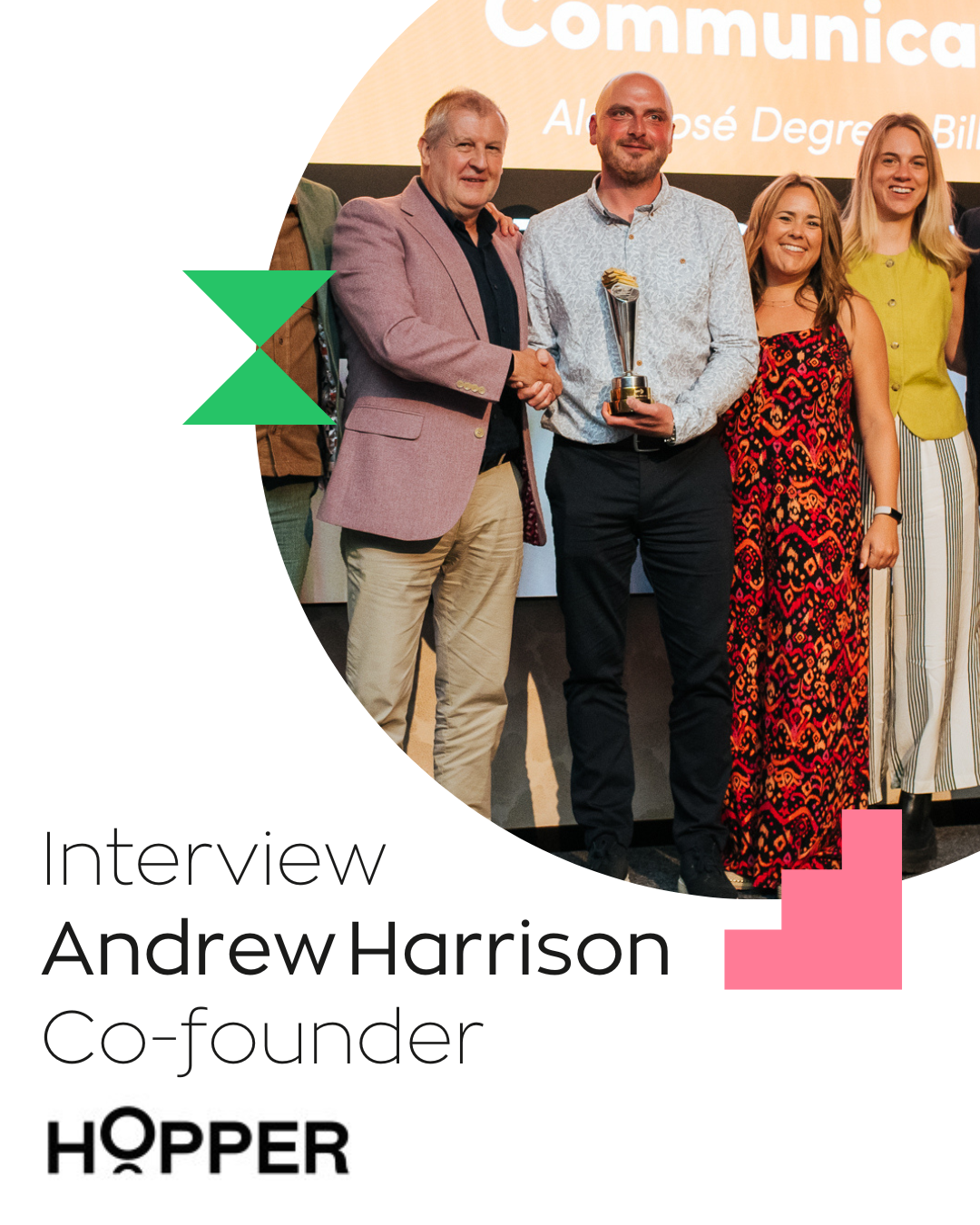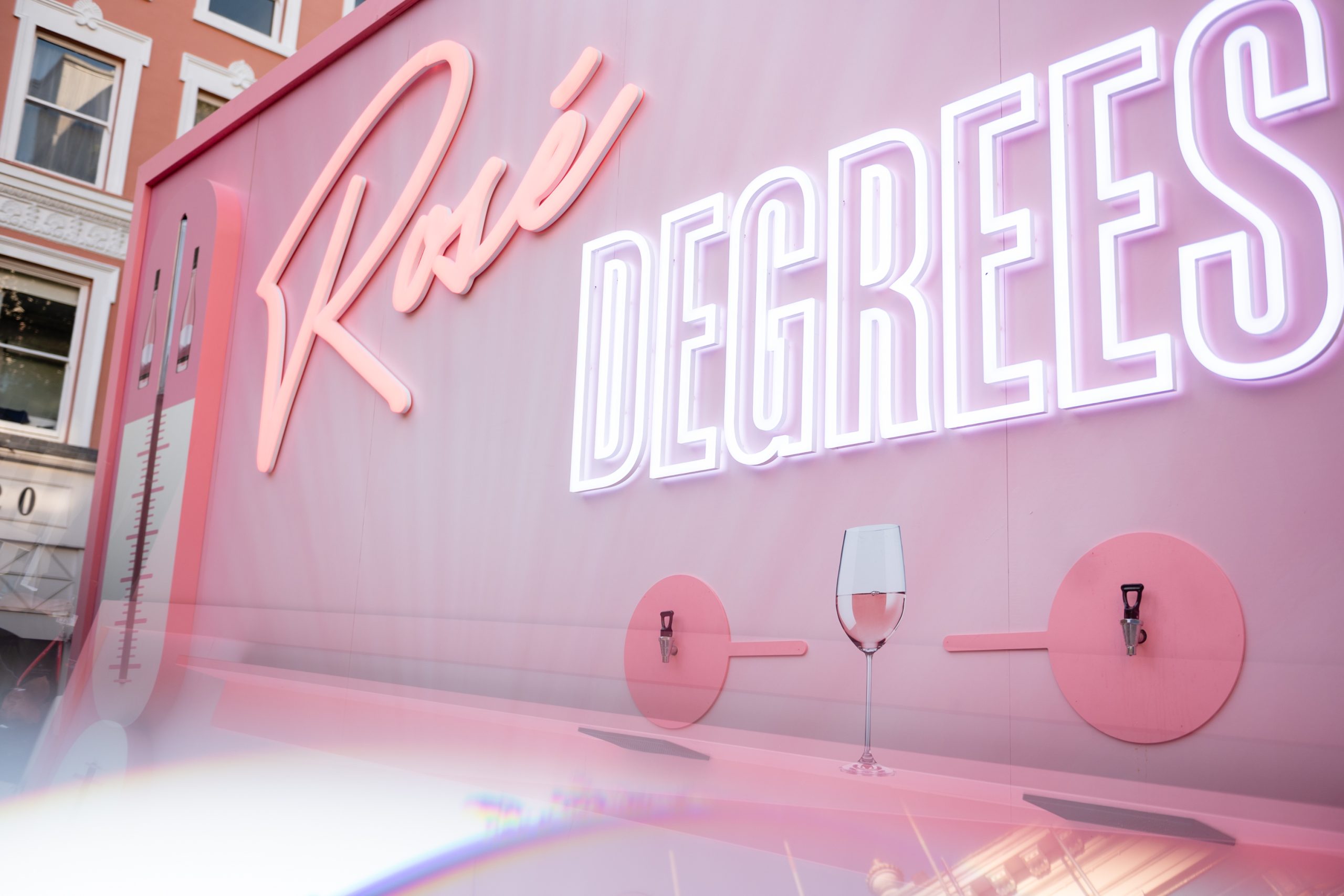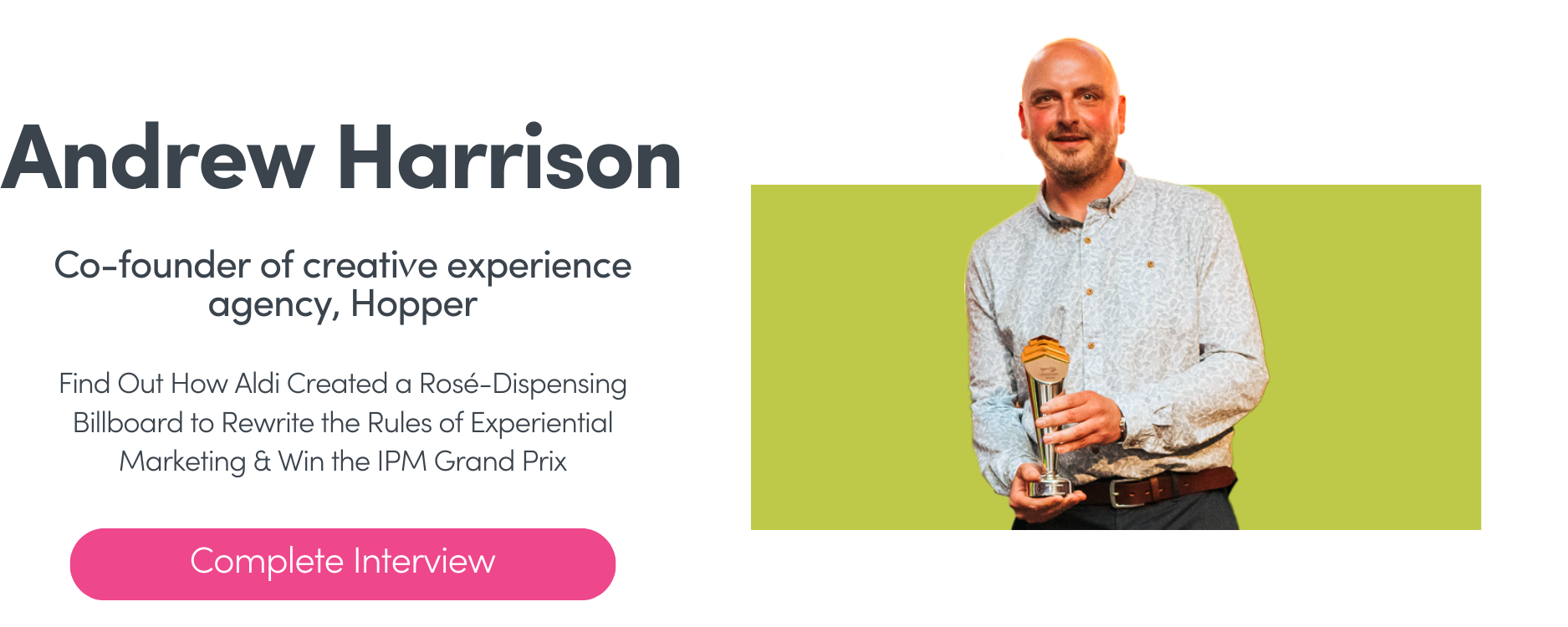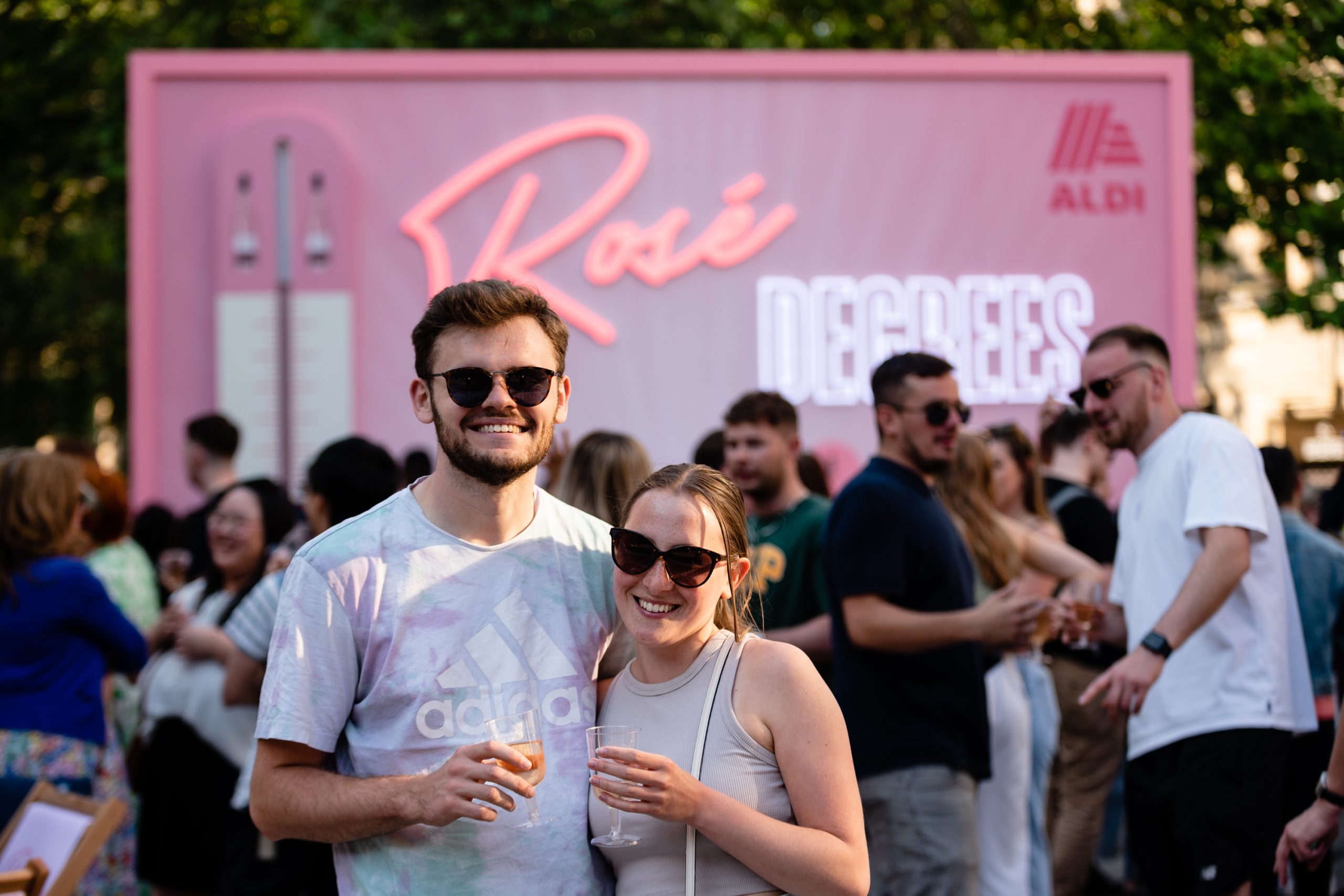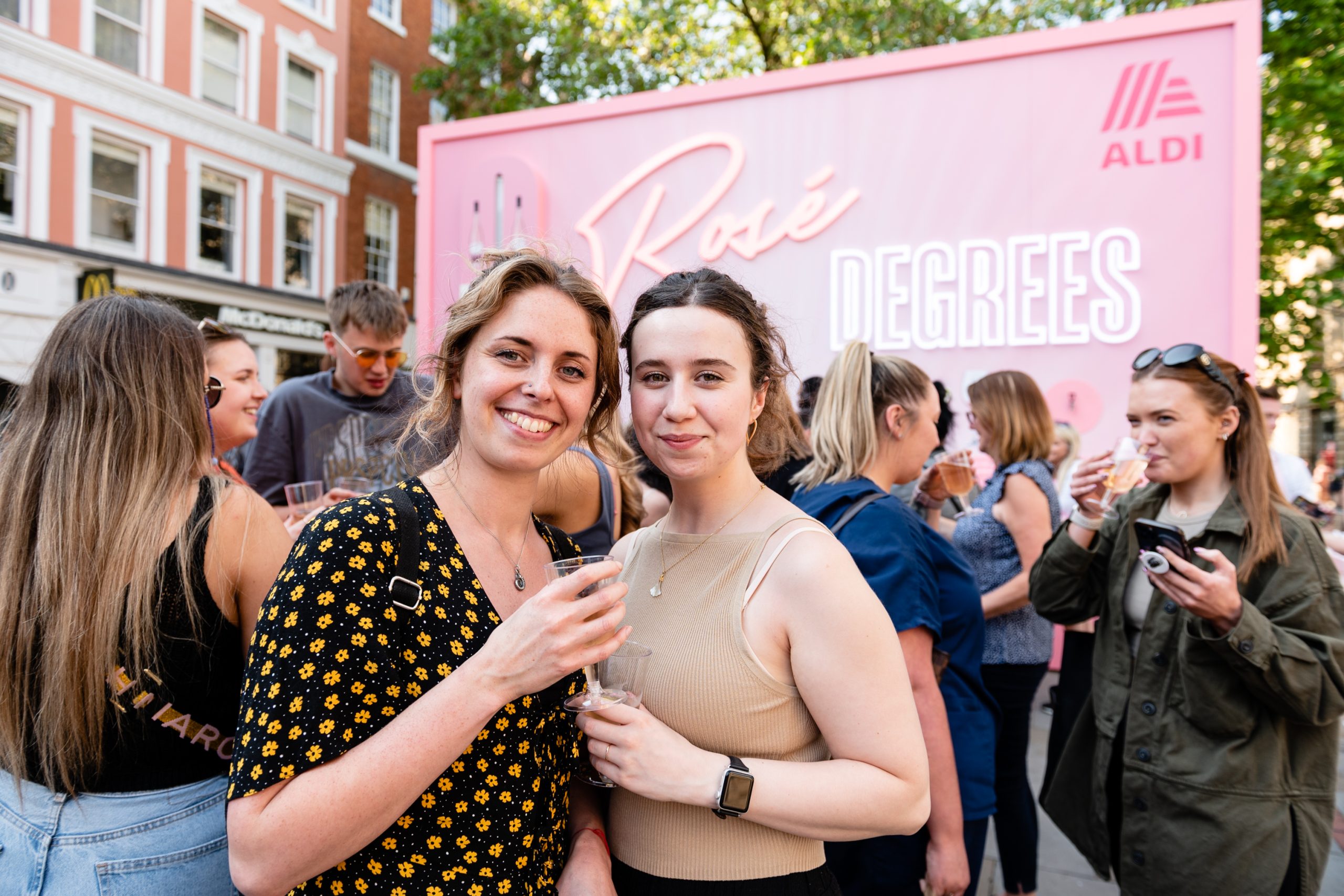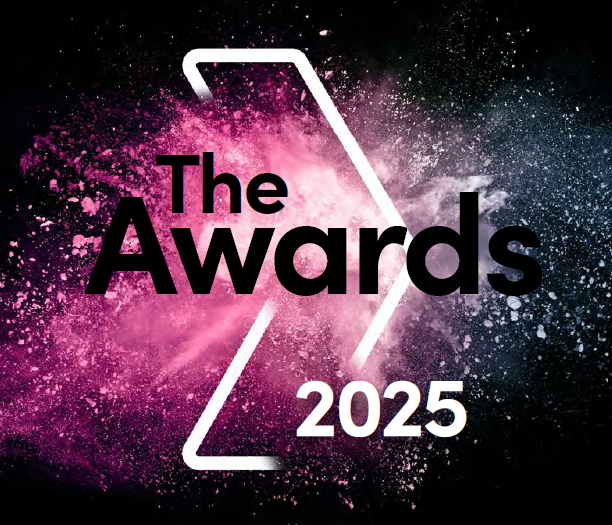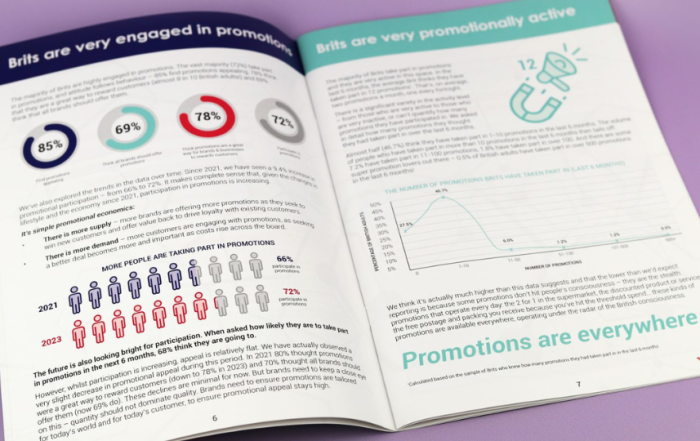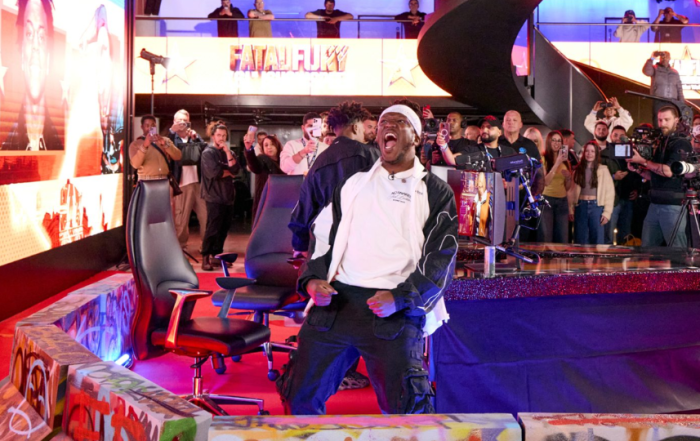
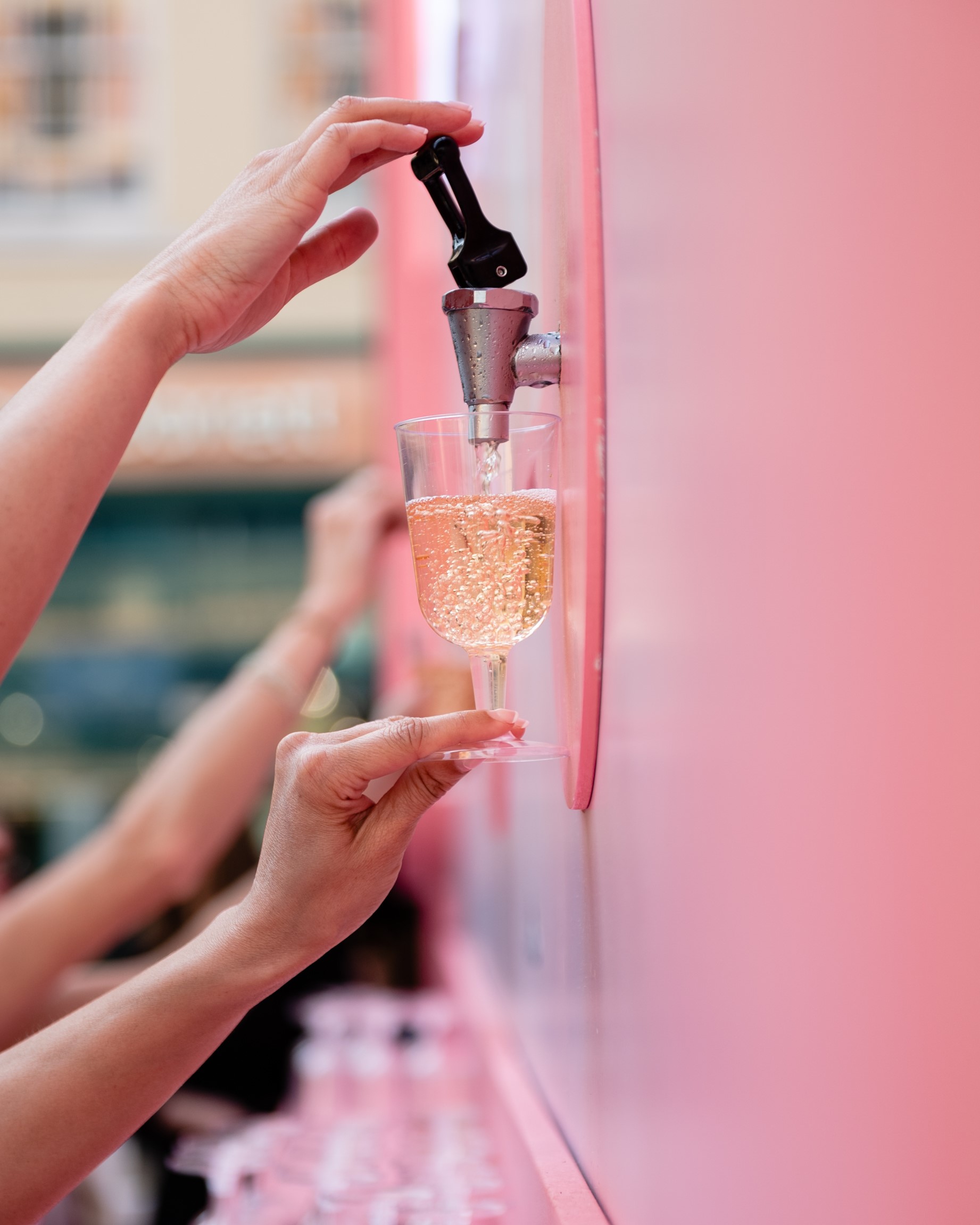
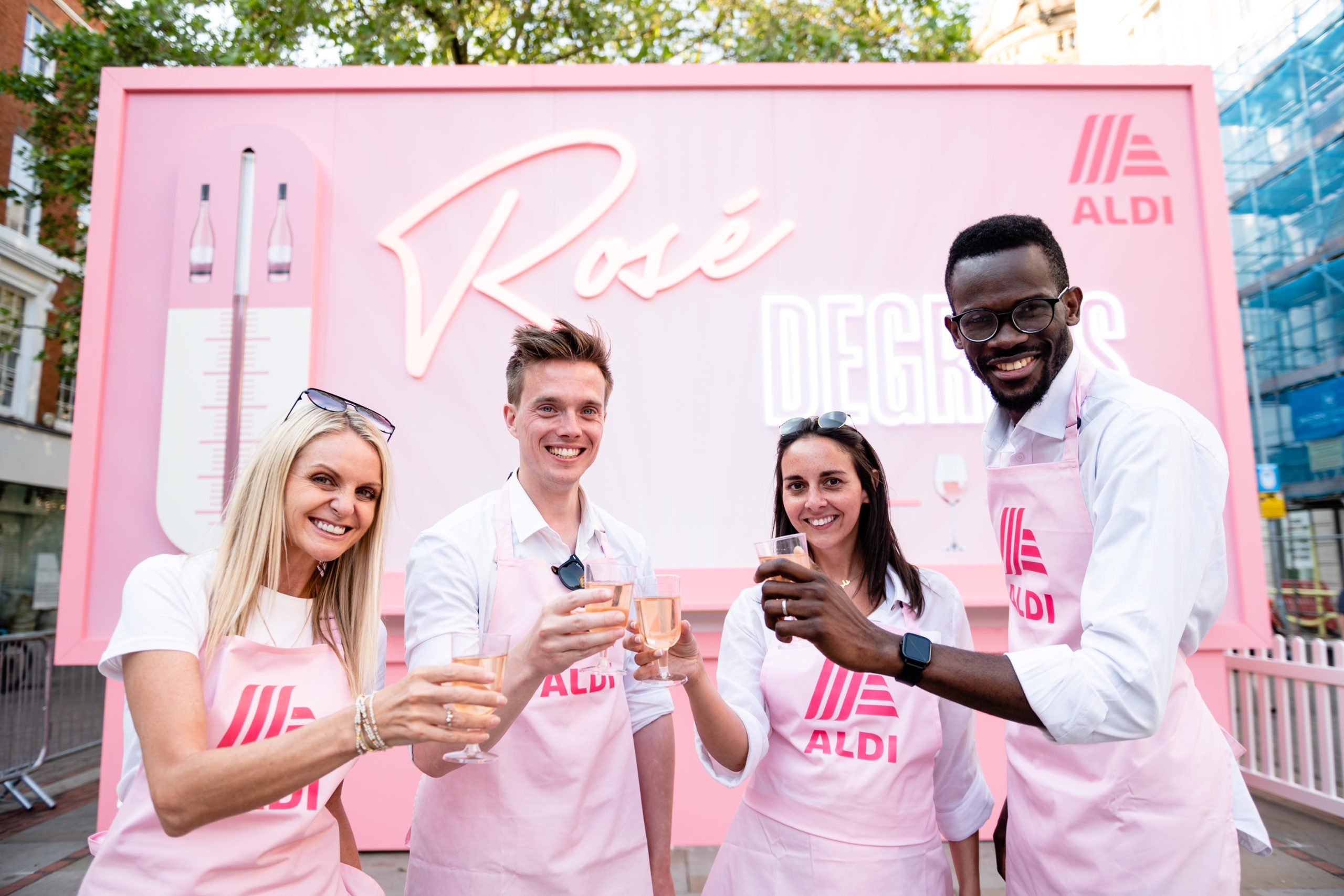
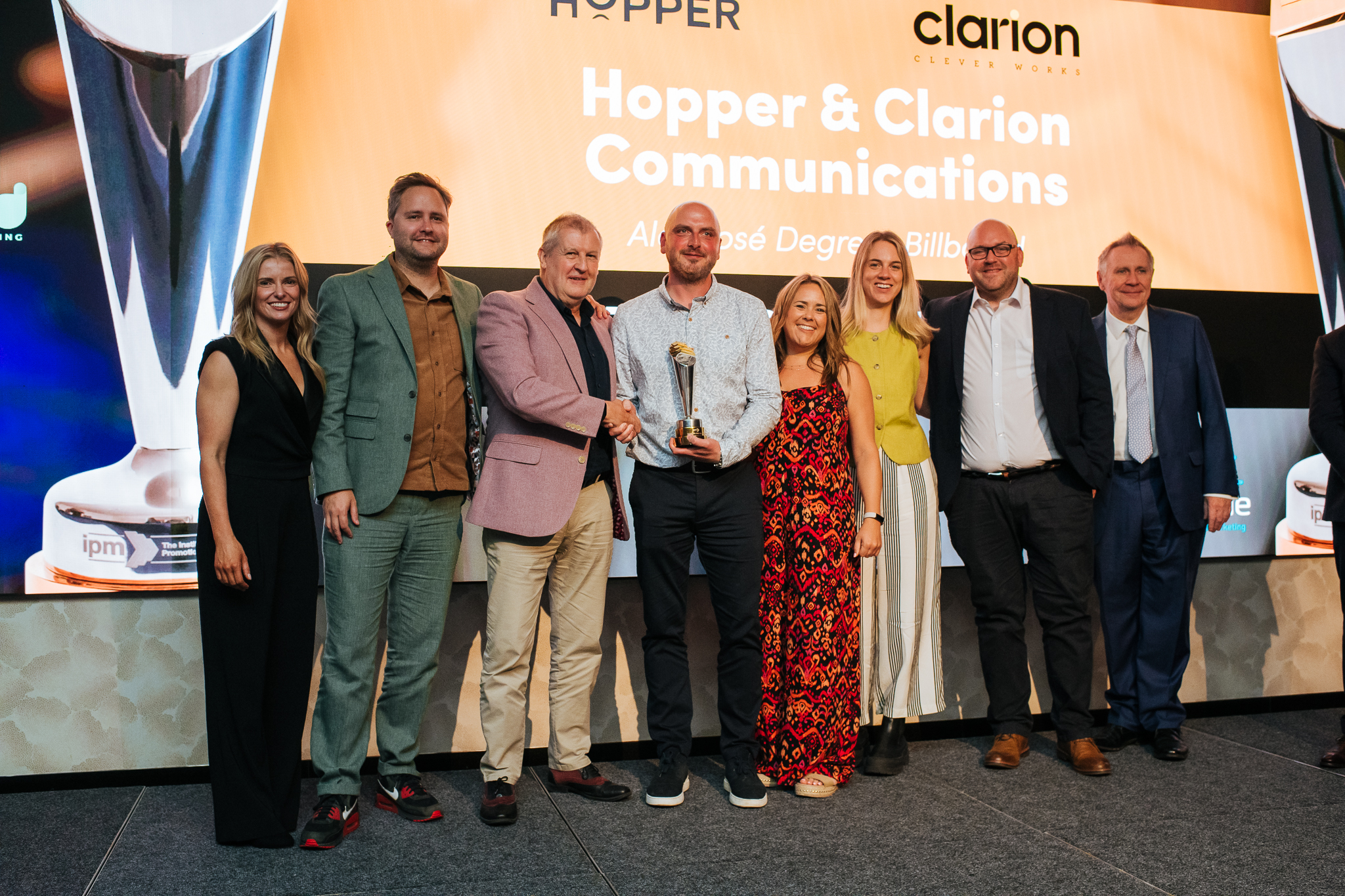


We’ve seen brands like McDonald’s and Lynx experiment with aromatic billboards, but the Aldi Rosé Degrees Billboard took it to the next level by pouring rosé. What inspired you to take this bold creative leap and develop the world’s first rosé-dispensing billboard?
Take the BBC Dracula billboard, which used wooden stakes to form an image that glowed ominously at night, or Burger King’s fiery billboard, literally set alight to emphasise their ‘flame-grilled’ credentials. Specsavers also reinvented outdoor advertising with witty, disruptive billboards, consistently challenging traditional formats. These classic campaigns kick-started a real surge in creative billboards—often called “special builds”—that blur the lines between advertising and experience.
For Aldi, our goal was to take this concept even further. Working with Clarion Communications, we wanted to lead the conversation around rosé during a key time of year—summer—and firmly establish Aldi as a standout choice among supermarkets. We knew that a billboard would be the simplest, boldest way to make a statement, but coming from an experiential sampling background, we wanted to get people interacting with the product, rather than just snap a photo and walk away. How do we get people to taste the product? That’s how we ended up with the world’s first rosé-dispensing billboard. It wasn’t just about being seen—it was about being tasted and remembered.
We’ve seen brands like McDonald’s and Lynx experiment with aromatic billboards, but the Aldi Rosé Degrees Billboard took it to the next level by pouring rosé. What inspired you to take this bold creative leap and develop the world’s first rosé-dispensing billboard?
Take the BBC Dracula billboard, which used wooden stakes to form an image that glowed ominously at night, or Burger King’s fiery billboard, literally set alight to emphasise their ‘flame-grilled’ credentials. Specsavers also reinvented outdoor advertising with witty, disruptive billboards, consistently challenging traditional formats. These classic campaigns kick-started a real surge in creative billboards—often called “special builds”—that blur the lines between advertising and experience.
For Aldi, our goal was to take this concept even further. Working with Clarion Communications, we wanted to lead the conversation around rosé during a key time of year—summer—and firmly establish Aldi as a standout choice among supermarkets. We knew that a billboard would be the simplest, boldest way to make a statement, but coming from an experiential sampling background, we wanted to get people interacting with the product, rather than just snap a photo and walk away. How do we get people to taste the product? That’s how we ended up with the world’s first rosé-dispensing billboard. It wasn’t just about being seen—it was about being tasted and remembered.

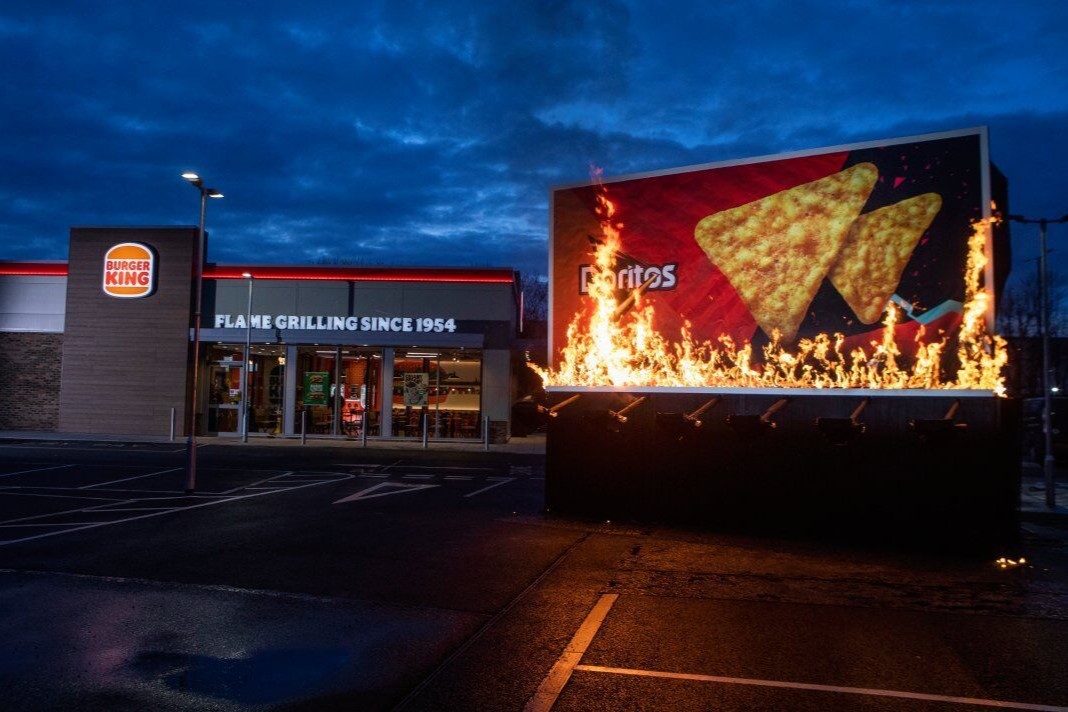
The campaign centred around a very specific temperature—19.2°C—what was so special about that number and how did it shape your creative approach?
The wine category is filled with generic claims—‘wine o’clock’ is one slogan that everyone knows, but it’s not something any one brand can truly own. We wanted to break away from these well-worn phrases and create something fresh that spoke to Aldi’s challenger spirit.
Clarion conducted insightful research across the UK to pinpoint the perfect temperature when people felt most inclined to enjoy a chilled glass of rosé. It turned out that 19.2°C was the magic number. And that insight became our anchor. Instead of relying on time-based clichés, we leaned into temperature.
The result? When the thermometer hit 19.2°C, that’s when the taps opened, and the rosé started flowing. It inspired everything—from the neon ‘Rosé Degrees’ sign to the giant thermometer that filled with rosé instead of mercury. Temperature rising was central to the story, building anticipation as the degrees climbed and the rosé filled the thermometer.
The campaign centred around a very specific temperature—19.2°C—what was so special about that number and how did it shape your creative approach?
The wine category is filled with generic claims—‘wine o’clock’ is one slogan that everyone knows, but it’s not something any one brand can truly own. We wanted to break away from these well-worn phrases and create something fresh that spoke to Aldi’s challenger spirit.
Clarion conducted insightful research across the UK to pinpoint the perfect temperature when people felt most inclined to enjoy a chilled glass of rosé. It turned out that 19.2°C was the magic number. And that insight became our anchor. Instead of relying on time-based clichés, we leaned into temperature.
The result? When the thermometer hit 19.2°C, that’s when the taps opened, and the rosé started flowing. It inspired everything—from the neon ‘Rosé Degrees’ sign to the giant thermometer that filled with rosé instead of mercury. Temperature rising was central to the story, building anticipation as the degrees climbed and the rosé filled the thermometer.
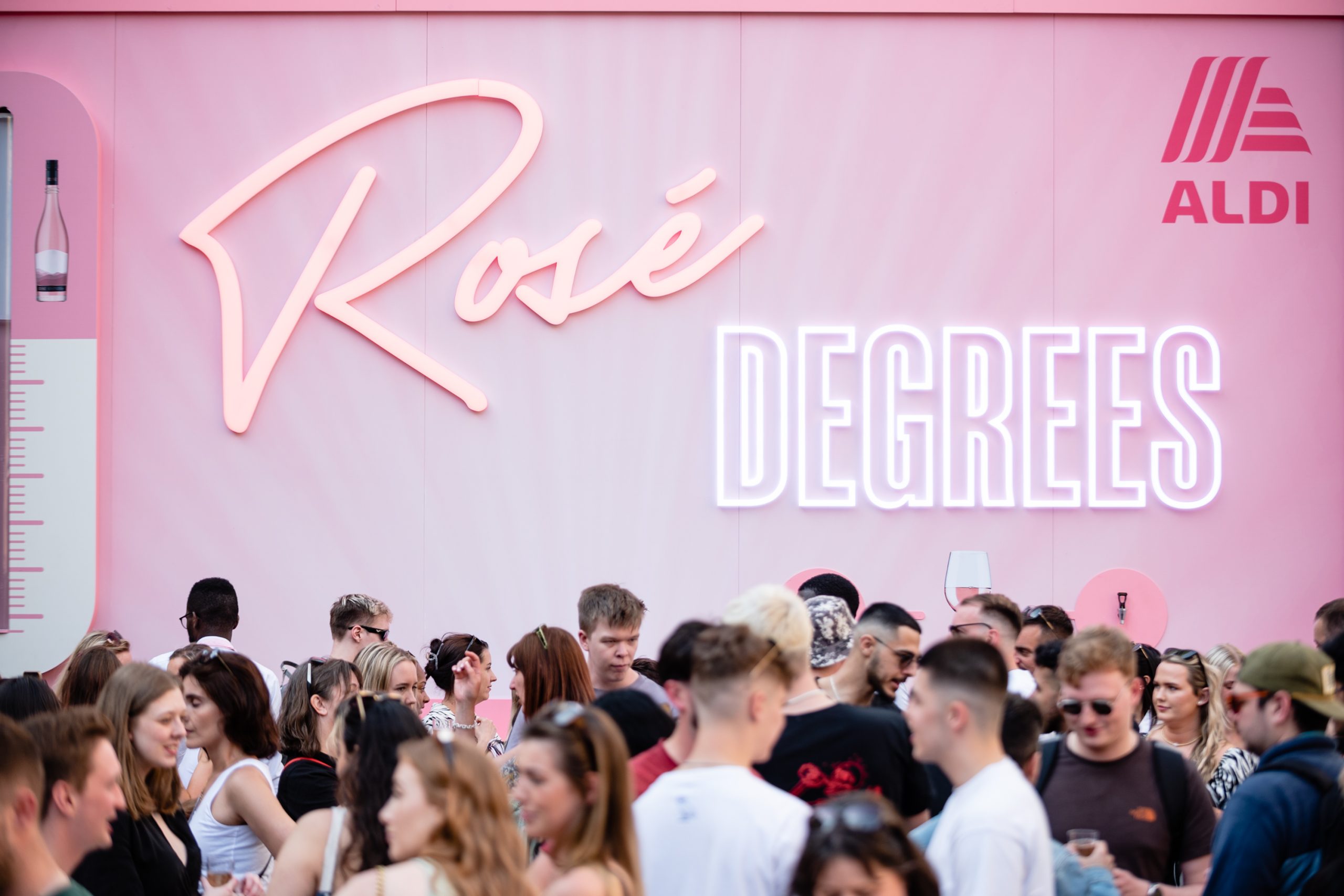
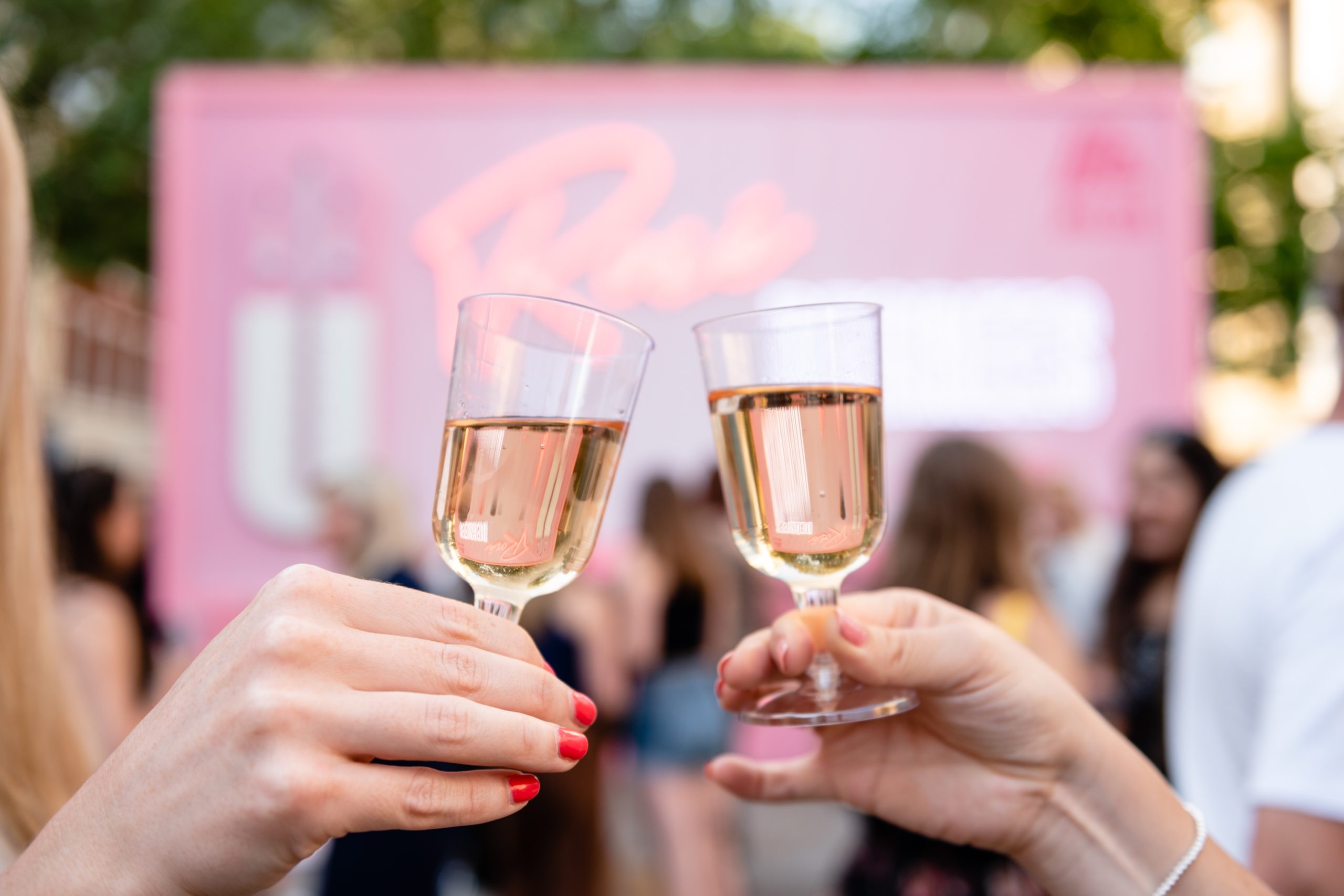
Why did you choose Manchester for this activation, and how did you manage the unpredictable weather, which played a crucial role in the success of this campaign?
We chose Manchester for a couple of key reasons, but a big part of it was data-driven. Clarion’s research revealed that Manchester, per capita, drinks more rosé than any other region in the UK. So why wouldn’t we go there and celebrate that with a region that genuinely loves the product?
Activating in Manchester instead of London also allowed us to step away from the norm. Most of these kinds of activations tend to default to London because of the media presence, but we wanted to connect directly with the local culture of Manchester, and the response was phenomenal. Local media elevated the campaign, giving it another level of visibility and emotional resonance with the community.
Regarding the weather—yes, we had to embrace the unpredictability of the great British climate. We kept a close eye on the long-term forecast to ensure we had a sunny window for the activation, but the reality of any outdoor campaign in the UK is that you need to be ready to adapt. If the weather had turned, our approach was to lean into it. Aldi is a brand that doesn’t take itself too seriously, and if the rain had come, we were ready to put a fun spin on it—celebrating a chilled glass of rosé come rain or shine. It’s all about staying flexible and having a narrative ready for every scenario.
Clarion’s research revealed that Manchester, per capita, drinks more rosé than any other region in the UK. So why wouldn’t we go there and celebrate that with a region that genuinely loves the product?
Aldi has been on a roll with some seriously fun campaigns this year, from bottomless pigs in blankets to a rosé-dispensing billboard. How did you manage bringing Aldi’s brand identity to life across these activations?
Aldi doesn’t take itself too seriously—it’s about keeping things simple, light, and relevant. Across these campaigns, whether it’s rosé or pigs in blankets, we always start with a really simple but relatable insight—something that makes people nod along, smile, or laugh because they know it’s true. With the Bottomless Pigs in Blankets restaurant, it was built around the idea that almost everyone loves pigs in blankets. It’s voted the number three item on Christmas dinner plates in the UK. So we took this relevant human truth and created a pop-up restaurant, complete with a golden ‘Press for PIBs’ buzzer to unlock unlimited courses.
The key to all of these activations is simplicity of message. We aim to make the core idea clear within a few seconds—something people can immediately understand and enjoy. Once we have that hook, we layer in detail, which is so important because unlike other forms of marketing, experiential campaigns like this allow people to spend 10 to 15 minutes not just taking in the visuals but interacting with staff, tasting the product, and learning where to buy it. Every touchpoint has to be carefully thought through, from the custom-branded pink aprons worn by staff to the bespoke recycling bins that reinforced Aldi’s sustainability message.
The same meticulous attention to detail applies to the Pigs in Blankets restaurant. From cocktail napkins with the Aldi logo to the colour scheme and even the functionality of the ‘Press for PIBs’ button, every element was designed to immerse people in the experience. It’s these small but meaningful touches that elevate a campaign from good to great, creating something that people not only enjoy but also remember.
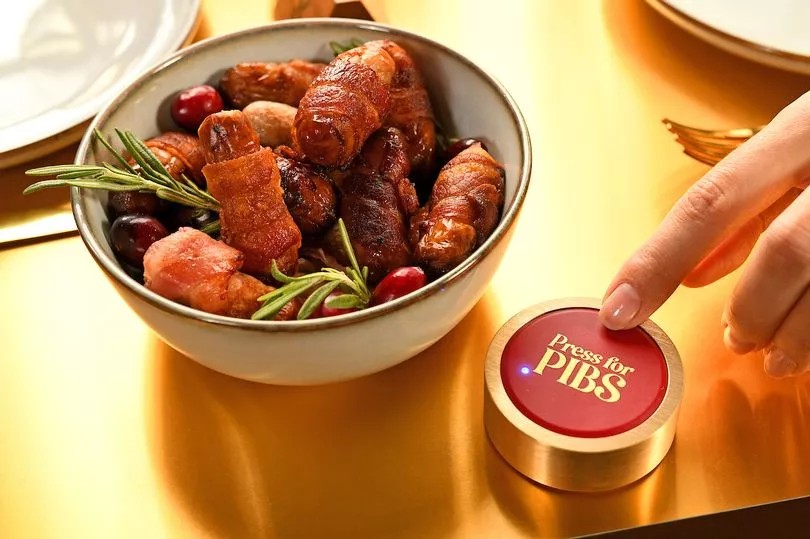
With a social media reach of over 5.4 million and extensive coverage in both regional and national press, how did you approach the design to ensure it was not only visually striking in real life, but also highly impactful across mainstream press and social media platforms like Instagram and TikTok?
The success of this campaign hinged on the collaboration between Clarion, the lead PR agency, and Hopper, who executed the real-world experience.
Clarion’s “Clever Works” ethos focuses on building reach and fame by aligning every aspect of the campaign—from PR to social media to experiential elements. Hopper’s role was to take that narrative and translate it into a bold, disruptive execution that not only worked in the real world but also amplified the PR message. Together, this approach ensured that every element—from the initial concept to the final activation—created maximum impact.
When designing for social media, we knew it had to work effortlessly on a phone screen. The visuals needed to be bold, vibrant, and instantly recognisable. That’s why the entire activation embraced a consistent bright pink theme. From the neon lights to the thermometer, from the staff uniforms to the deck chairs, and even the influencer goodie bags—everything was pink. This simplicity of colour and design made the activation stand out on Instagram, TikTok, and in the press.
Clarion Communications also ensured the campaign was shareable by inviting key influencers and media personalities, including wine bloggers, bar and restaurant reviewers, and trendsetters known for covering TikTok crazes like the jalapeño rosé trend. This mix of local media, national press, and influencers created layers of coverage that extended the campaign’s reach.
The key to this design was making it irresistible to photograph and film. By flooding screens with a single, consistent colour and focusing on clear, simple messaging, we avoided the confusion that can come from using too many colours or conflicting visuals. The result was something that not only caught attention in person but also popped on social media feeds, where clarity and vibrancy are everything.
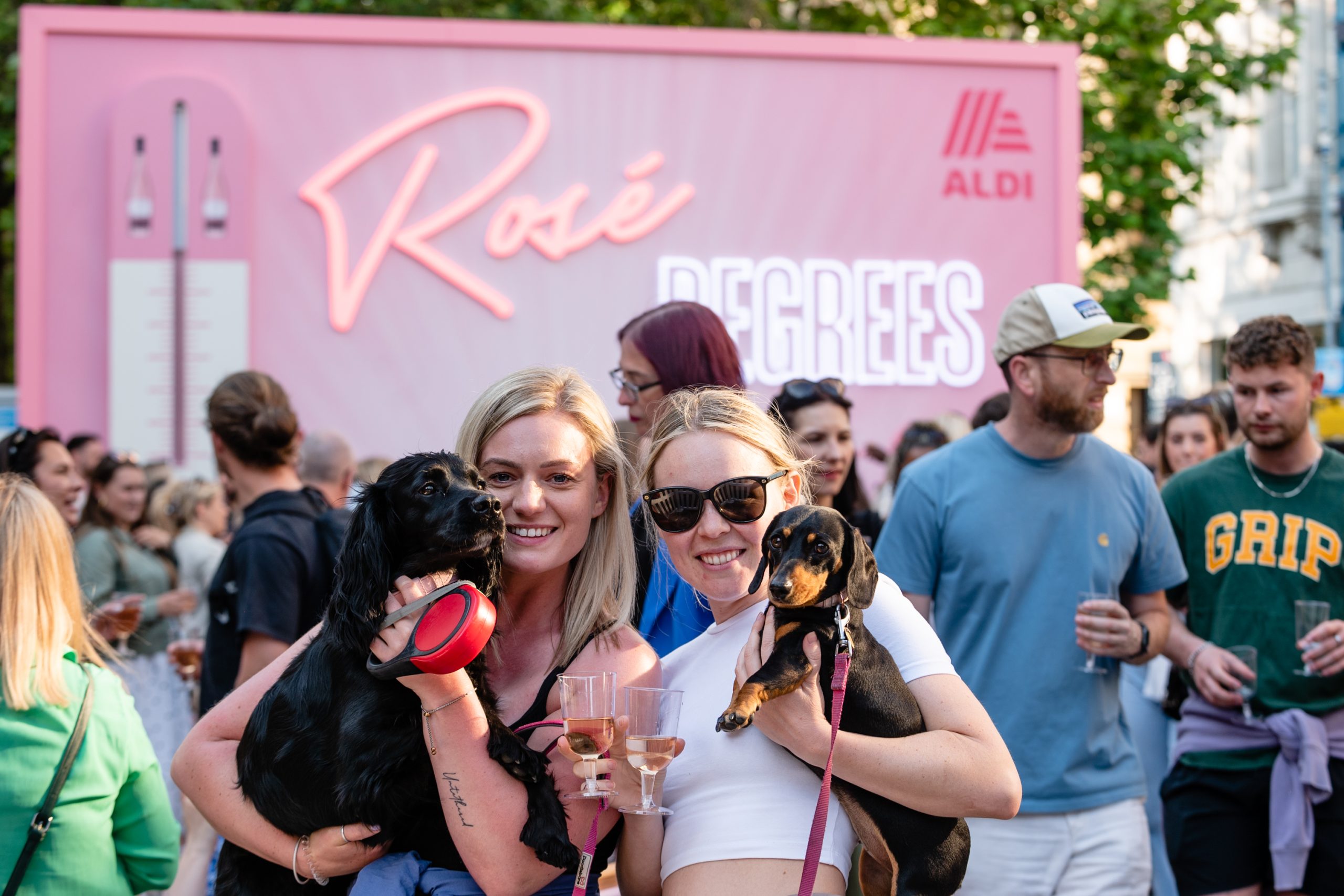
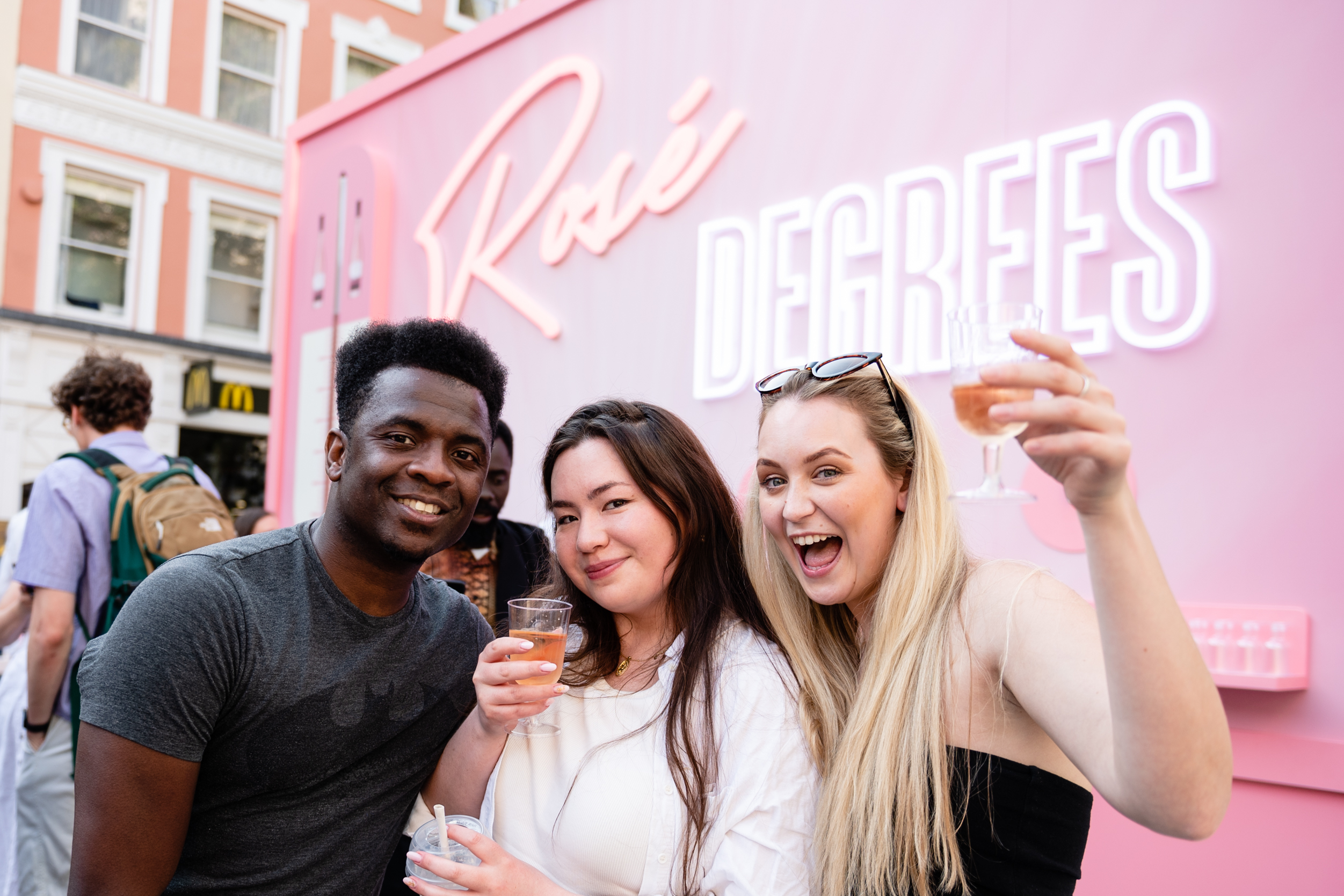
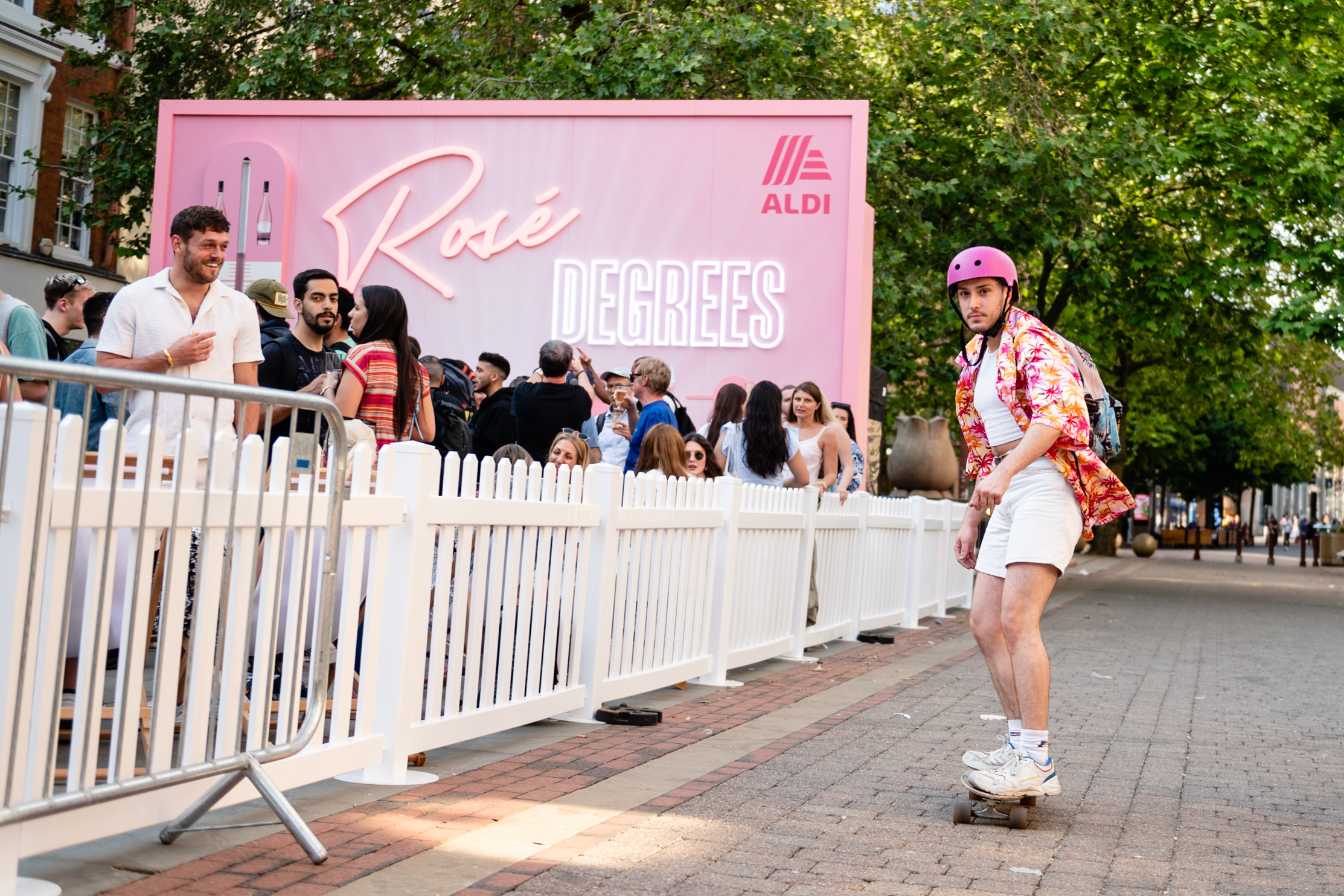
Do you see this as a billboard, or a brand experience? How do you think this blending of advertising and experiential marketing will shape future of consumer interactions?
It’s both. I know that sounds like a politician’s answer, but it truly is. The rosé billboard functioned as a traditional advertising format, but the way we executed it transformed it into a fully-fledged experiential campaign. It allowed us to meet people face-to-face, let them taste the product, and have real conversations with the brand. At the same time, it gave people something to capture and share, turning it into a highly interactive form of advertising.
We live in an age where everyone is a content creator. People are constantly looking for experiences they can share—whether to stand out among their friends or to connect with their social circles. This hunger for shareable moments has been one of the biggest drivers of experiential marketing, particularly as it intersects with social media. The rosé billboard tapped into this perfectly by offering something visually striking, fun to engage with, and easy to share.
When designing for social media, we knew it had to work effortlessly on a phone screen. The visuals needed to be bold, vibrant, and instantly recognisable. That’s why the entire activation embraced a consistent bright pink theme. From the neon lights to the thermometer, from the staff uniforms to the deck chairs, and even the influencer goodie bags—everything was pink. This simplicity of colour and design made the activation stand out on Instagram, TikTok, and in the press.
Clarion Communications also ensured the campaign was shareable by inviting key influencers and media personalities, including wine bloggers, bar and restaurant reviewers, and trendsetters known for covering TikTok crazes like the jalapeño rosé trend. This mix of local media, national press, and influencers created layers of coverage that extended the campaign’s reach.
The key to this design was making it irresistible to photograph and film. By flooding screens with a single, consistent colour and focusing on clear, simple messaging, we avoided the confusion that can come from using too many colours or conflicting visuals. The result was something that not only caught attention in person but also popped on social media feeds, where clarity and vibrancy are everything.
We live in an age where everyone is a content creator. People are constantly looking for experiences they can share… This hunger for shareable moments has been one of the biggest drivers of experiential marketing.
In many ways, experiential marketing and traditional advertising can learn from each other. Advertising is exceptional at storytelling and evoking emotions—whether it’s fun, nostalgia, or adrenaline—and experiential marketing can benefit from weaving emotional hooks into its campaigns. On the flip side, experiential marketing provides something advertising often lacks: a two-way conversation. Traditional ads broadcast messages, but people now want to interact with brands, influence how they think, and feel connected. Experiential campaigns like the rosé billboard invite that dialogue, creating moments that are as much about listening as they are about speaking.
This blending of formats offers the best of both worlds. It turns a static medium like a billboard into something dynamic and interactive. For example, people didn’t just see the billboard; they tasted the rosé, shared their thoughts, and then captured their own content to share with friends. That level of interaction builds deeper connections with consumers, making the brand feel approachable and brave—brave enough to meet people where they are.
Looking ahead, I believe we’ll see more campaigns like this—fusing advertising, experiential marketing, and social media into cohesive experiences. The more we demonstrate the return on investment, like the regional and national spikes in rosé sales we saw during this campaign, the more clients will invest in making these activations bigger and better. Imagine rolling out multiple rosé-dispensing billboards across the country, creating a network of interactive experiences. It’s these kinds of executions that will shape the future of consumer interactions by combining the emotional resonance of advertising with the participatory nature of experiential marketing.
What key advice would you offer to aspiring experiential marketers looking to create the next generation of impactful campaigns, especially considering the rapid changes in today’s marketing landscape?
My first piece of advice is to embrace the unique opportunities that experiential marketing offers. Clients turn to experiential because they want to do something different—something that disrupts, engages, and creates meaningful interactions with people. Unlike traditional media, experiential isn’t constrained by a screen size, a time limit, or a set format. You’re not limited to a 15-second ad, a short social video, or even the space of a product package. Experiential opens up almost limitless possibilities to connect with people face-to-face in creative, sensory-driven ways. The only real constraints are budget and feasibility, so the potential for innovation is huge.
Another key factor is bravery. Experiential marketing requires brands to step out of their comfort zones. It’s about being willing to meet consumers where they are—whether that’s in Manchester or at a pop-up activation in London—and to take the calculated risk of putting your product and message directly in front of them. There’s always the chance someone might not like what they experience and share that opinion online. But when brands are brave enough to invite people to taste, touch, or interact with their products and then share those moments on their own terms, it creates authenticity and builds trust. Consumers respect brands that show up, engage directly, and invite honest feedback.
Finally, remember that experiential marketing is about creating a two-way conversation. Traditional advertising often pushes a message to consumers, but experiential allows people to participate, react, and influence how they perceive a brand. This is where marketing is heading—a more interactive, dialogue-driven approach. If you can design campaigns that blend bold creativity with real opportunities for interaction, you’ll stand out in today’s crowded landscape.
My advice to aspiring experiential marketers is this: think beyond the constraints of other media, be brave enough to take risks, and design experiences that not only tell a story but invite people to become part of it. That’s how you’ll create campaigns that truly resonate and leave a lasting impact.
Be brave enough to take risks, and design experiences that not only tell a story but invite people to become part of it.
Taking home the prestigious IPM Grand Prix this year is a testament to the exceptional creativity and effectiveness of the Aldi Rosé Degrees Billboard campaign. What does this achievement mean for you and your team?
Honestly, it’s still sinking in—which I know sounds a bit cliché—but it truly was a shock for us on the night. We’ve always believed in this campaign, not just because of its creativity but also because of the tangible impact it had on sales and media coverage. We knew it was a strong contender, but when you’re up against big agencies, big brands, and big budgets, it’s still a massive and wonderful surprise to win the Grand Prix.
What makes us especially proud is that this wasn’t the biggest-budget campaign on the night. What we demonstrated was how insight can translate into creativity, and creativity into measurable results. That combination is what helped the campaign stand out. Winning the Grand Prix really validates our approach and gives us the confidence to keep pushing the boundaries by bringing PR, social, and experiential together right from the start of a campaign.
Traditionally, experiential has often been seen as an afterthought—a channel that’s added on at the end of a campaign, budget permitting. But with this campaign, we worked with Clarion and Aldi from the outset to create something truly integrated. In fact, we often start with the experiential execution, asking: how can we meet people face-to-face and create a memorable experience? From there, we built out the PR and social elements to amplify the story. That’s a big shift from the way things were done 15 or 20 years ago, and this win shows that the approach works.
For us, the Rosé Degrees billboard is the embodiment of how experiential, PR, and social can combine to tell a cohesive, impactful story. Winning the Grand Prix gives us a stronger platform to talk to clients about this integrated approach—demonstrating that experiential isn’t just an add-on but a central part of the creative strategy.
It also feels like a big moment for experiential marketing as a whole. For an experiential execution to win the IPM Grand Prix alongside traditional channels puts experiential on the same level, showing it’s just as impactful and vital to the overall marketing mix. It’s a proud moment for our team and a step forward for the industry.
Thank you, Andrew, for taking us behind the scenes of the award-winning Aldi Rosé Degrees Billboard campaign. Congratulations to Hopper for clinching the IPM Grand Prix and pouring new life into experiential marketing!
Why did you choose Manchester for this activation, and how did you manage the unpredictable weather, which played a crucial role in the success of this campaign?
We chose Manchester for a couple of key reasons, but a big part of it was data-driven. Clarion’s research revealed that Manchester, per capita, drinks more rosé than any other region in the UK. So why wouldn’t we go there and celebrate that with a region that genuinely loves the product?
Activating in Manchester instead of London also allowed us to step away from the norm. Most of these kinds of activations tend to default to London because of the media presence, but we wanted to connect directly with the local culture of Manchester, and the response was phenomenal. Local media elevated the campaign, giving it another level of visibility and emotional resonance with the community.
Regarding the weather—yes, we had to embrace the unpredictability of the great British climate. We kept a close eye on the long-term forecast to ensure we had a sunny window for the activation, but the reality of any outdoor campaign in the UK is that you need to be ready to adapt. If the weather had turned, our approach was to lean into it. Aldi is a brand that doesn’t take itself too seriously, and if the rain had come, we were ready to put a fun spin on it—celebrating a chilled glass of rosé come rain or shine. It’s all about staying flexible and having a narrative ready for every scenario.
“Clarion’s research revealed that Manchester, per capita, drinks more rosé than any other region in the UK. So why wouldn’t we go there and celebrate that with a region that genuinely loves the product?”
Aldi has been on a roll with some seriously fun campaigns this year, from bottomless pigs in blankets to a rosé-dispensing billboard. How did you manage bringing Aldi’s brand identity to life across these activations?
Aldi doesn’t take itself too seriously—it’s about keeping things simple, light, and relevant. Across these campaigns, whether it’s rosé or pigs in blankets, we always start with a really simple but relatable insight—something that makes people nod along, smile, or laugh because they know it’s true. With the Bottomless Pigs in Blankets restaurant, it was built around the idea that almost everyone loves pigs in blankets. It’s voted the number three item on Christmas dinner plates in the UK. So we took this relevant human truth and created a pop-up restaurant, complete with a golden ‘Press for PIBs’ buzzer to unlock unlimited courses.
The key to all of these activations is simplicity of message. We aim to make the core idea clear within a few seconds—something people can immediately understand and enjoy. Once we have that hook, we layer in detail, which is so important because unlike other forms of marketing, experiential campaigns like this allow people to spend 10 to 15 minutes not just taking in the visuals but interacting with staff, tasting the product, and learning where to buy it. Every touchpoint has to be carefully thought through, from the custom-branded pink aprons worn by staff to the bespoke recycling bins that reinforced Aldi’s sustainability message.
The same meticulous attention to detail applies to the Pigs in Blankets restaurant. From cocktail napkins with the Aldi logo to the colour scheme and even the functionality of the ‘Press for PIBs’ button, every element was designed to immerse people in the experience. It’s these small but meaningful touches that elevate a campaign from good to great, creating something that people not only enjoy but also remember.
With a social media reach of over 5.4 million and extensive coverage in both regional and national press, how did you approach the design to ensure it was not only visually striking in real life, but also highly impactful across mainstream press and social media platforms like Instagram and TikTok?
The success of this campaign hinged on the collaboration between Clarion, the lead PR agency, and Hopper, who executed the real-world experience.
Clarion’s “Clever Works” ethos focuses on building reach and fame by aligning every aspect of the campaign—from PR to social media to experiential elements. Hopper’s role was to take that narrative and translate it into a bold, disruptive execution that not only worked in the real world but also amplified the PR message. Together, this approach ensured that every element—from the initial concept to the final activation—created maximum impact.
When designing for social media, we knew it had to work effortlessly on a phone screen. The visuals needed to be bold, vibrant, and instantly recognisable. That’s why the entire activation embraced a consistent bright pink theme. From the neon lights to the thermometer, from the staff uniforms to the deck chairs, and even the influencer goodie bags—everything was pink. This simplicity of colour and design made the activation stand out on Instagram, TikTok, and in the press.
Clarion Communications also ensured the campaign was shareable by inviting key influencers and media personalities, including wine bloggers, bar and restaurant reviewers, and trendsetters known for covering TikTok crazes like the jalapeño rosé trend. This mix of local media, national press, and influencers created layers of coverage that extended the campaign’s reach.
The key to this design was making it irresistible to photograph and film. By flooding screens with a single, consistent colour and focusing on clear, simple messaging, we avoided the confusion that can come from using too many colours or conflicting visuals. The result was something that not only caught attention in person but also popped on social media feeds, where clarity and vibrancy are everything.
Do you see this as a billboard, or a brand experience? How do you think this blending of advertising and experiential marketing will shape future of consumer interactions?
It’s both. I know that sounds like a politician’s answer, but it truly is. The rosé billboard functioned as a traditional advertising format, but the way we executed it transformed it into a fully-fledged experiential campaign. It allowed us to meet people face-to-face, let them taste the product, and have real conversations with the brand. At the same time, it gave people something to capture and share, turning it into a highly interactive form of advertising.
We live in an age where everyone is a content creator. People are constantly looking for experiences they can share—whether to stand out among their friends or to connect with their social circles. This hunger for shareable moments has been one of the biggest drivers of experiential marketing, particularly as it intersects with social media. The rosé billboard tapped into this perfectly by offering something visually striking, fun to engage with, and easy to share.
“We live in an age where everyone is a content creator. People are constantly looking for experiences they can share… This hunger for shareable moments has been one of the biggest drivers of experiential marketing.”
In many ways, experiential marketing and traditional advertising can learn from each other. Advertising is exceptional at storytelling and evoking emotions—whether it’s fun, nostalgia, or adrenaline—and experiential marketing can benefit from weaving emotional hooks into its campaigns. On the flip side, experiential marketing provides something advertising often lacks: a two-way conversation. Traditional ads broadcast messages, but people now want to interact with brands, influence how they think, and feel connected. Experiential campaigns like the rosé billboard invite that dialogue, creating moments that are as much about listening as they are about speaking.
This blending of formats offers the best of both worlds. It turns a static medium like a billboard into something dynamic and interactive. For example, people didn’t just see the billboard; they tasted the rosé, shared their thoughts, and then captured their own content to share with friends. That level of interaction builds deeper connections with consumers, making the brand feel approachable and brave—brave enough to meet people where they are.
Looking ahead, I believe we’ll see more campaigns like this—fusing advertising, experiential marketing, and social media into cohesive experiences. The more we demonstrate the return on investment, like the regional and national spikes in rosé sales we saw during this campaign, the more clients will invest in making these activations bigger and better. Imagine rolling out multiple rosé-dispensing billboards across the country, creating a network of interactive experiences. It’s these kinds of executions that will shape the future of consumer interactions by combining the emotional resonance of advertising with the participatory nature of experiential marketing.


What key advice would you offer to aspiring experiential marketers looking to create the next generation of impactful campaigns, especially considering the rapid changes in today’s marketing landscape?
My first piece of advice is to embrace the unique opportunities that experiential marketing offers. Clients turn to experiential because they want to do something different—something that disrupts, engages, and creates meaningful interactions with people. Unlike traditional media, experiential isn’t constrained by a screen size, a time limit, or a set format. You’re not limited to a 15-second ad, a short social video, or even the space of a product package. Experiential opens up almost limitless possibilities to connect with people face-to-face in creative, sensory-driven ways. The only real constraints are budget and feasibility, so the potential for innovation is huge.
Another key factor is bravery. Experiential marketing requires brands to step out of their comfort zones. It’s about being willing to meet consumers where they are—whether that’s in Manchester or at a pop-up activation in London—and to take the calculated risk of putting your product and message directly in front of them. There’s always the chance someone might not like what they experience and share that opinion online. But when brands are brave enough to invite people to taste, touch, or interact with their products and then share those moments on their own terms, it creates authenticity and builds trust. Consumers respect brands that show up, engage directly, and invite honest feedback.
Finally, remember that experiential marketing is about creating a two-way conversation. Traditional advertising often pushes a message to consumers, but experiential allows people to participate, react, and influence how they perceive a brand. This is where marketing is heading—a more interactive, dialogue-driven approach. If you can design campaigns that blend bold creativity with real opportunities for interaction, you’ll stand out in today’s crowded landscape.
My advice to aspiring experiential marketers is this: think beyond the constraints of other media, be brave enough to take risks, and design experiences that not only tell a story but invite people to become part of it. That’s how you’ll create campaigns that truly resonate and leave a lasting impact.
“Be brave enough to take risks, and design experiences that not only tell a story but invite people to become part of it.”
Taking home the prestigious IPM Grand Prix this year is a testament to the exceptional creativity and effectiveness of the Aldi Rosé Degrees Billboard campaign. What does this achievement mean for you and your team?
Honestly, it’s still sinking in—which I know sounds a bit cliché—but it truly was a shock for us on the night. We’ve always believed in this campaign, not just because of its creativity but also because of the tangible impact it had on sales and media coverage. We knew it was a strong contender, but when you’re up against big agencies, big brands, and big budgets, it’s still a massive and wonderful surprise to win the Grand Prix.
What makes us especially proud is that this wasn’t the biggest-budget campaign on the night. What we demonstrated was how insight can translate into creativity, and creativity into measurable results. That combination is what helped the campaign stand out. Winning the Grand Prix really validates our approach and gives us the confidence to keep pushing the boundaries by bringing PR, social, and experiential together right from the start of a campaign.
Traditionally, experiential has often been seen as an afterthought—a channel that’s added on at the end of a campaign, budget permitting. But with this campaign, we worked with Clarion and Aldi from the outset to create something truly integrated. In fact, we often start with the experiential execution, asking: how can we meet people face-to-face and create a memorable experience? From there, we built out the PR and social elements to amplify the story. That’s a big shift from the way things were done 15 or 20 years ago, and this win shows that the approach works.
For us, the Rosé Degrees billboard is the embodiment of how experiential, PR, and social can combine to tell a cohesive, impactful story. Winning the Grand Prix gives us a stronger platform to talk to clients about this integrated approach—demonstrating that experiential isn’t just an add-on but a central part of the creative strategy.
It also feels like a big moment for experiential marketing as a whole. For an experiential execution to win the IPM Grand Prix alongside traditional channels puts experiential on the same level, showing it’s just as impactful and vital to the overall marketing mix. It’s a proud moment for our team and a step forward for the industry.
Thank you, Andrew, for taking us behind the scenes of the award-winning Aldi Rosé Degrees Billboard campaign. Congratulations to Hopper for clinching the IPM Grand Prix and pouring new life into experiential marketing!
Register your interest now for the IPM Awards 2025 and stay ahead of the curve by emailing awards@theipm.org.uk. Don’t miss your chance to be part of the next chapter in promotional marketing.
News
What Do Brits Want from Promotions in 2026
Get ready to unpack the promotional marketing landscape for 2026 as Mando, YouGov and the IPM prepare to launch What Brits Want from Promotions 3.0...
IPM Brings AI Marketing Debate to Westminster
AI in marketing goes on trial at the House of Commons, as MPs and industry leaders debate whether it is a partner or disruptor to promotional marketing.
Piccadilly Lights Goes from Billboard Icon to Experiential Capital
Piccadilly Lights, once the crown jewel of billboard advertising, is now the beating heart of experiential marketing in London, where brands don’t just advertise, they immerse.
IPM Awards 2025
Register your interest now for the IPM Awards 2025 by emailing awards@theipm.org.uk. Don’t miss your chance to be part of the next chapter in promotional marketing.
News
What Do Brits Want from Promotions in 2026
Get ready to unpack the promotional marketing landscape for 2026 as Mando, YouGov and the IPM prepare to launch What Brits Want from Promotions 3.0...
IPM Brings AI Marketing Debate to Westminster
AI in marketing goes on trial at the House of Commons, as MPs and industry leaders debate whether it is a partner or disruptor to promotional marketing.
Piccadilly Lights Goes from Billboard Icon to Experiential Capital
Piccadilly Lights, once the crown jewel of billboard advertising, is now the beating heart of experiential marketing in London, where brands don’t just advertise, they immerse.


